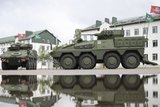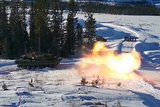Honeywell tests virtual window technology
Honeywell has successfully completed research and testing of 'virtual window' technology as part of DARPA's Ground X-Vehicle technologies programme, the company announced on 19 October.
The company has been working on technologies designed to enable operators of a windowless vehicle to 'see' the world outside, providing a natural viewing experience for in an indirect, windowless driving system.
Brian Aleksa, senior technical R&D manager at Honeywell, told Shephard that the aim of the research was to find out if a driver could operate a driving vehicle with the same relative comfort and confidence, as if the driver was driving a regular vehicle.
‘The current technologies are not that good for the operator of the vehicle. So, with an indirect driving system like this, enhanced situational awareness will allow the driver to not have to pop out his head which could subject the driver to a sniper, explosions nearby, or other threats,' said Aleksa.
In the first phase of the GXV-T programme Honeywell was one of a number of companies pursuing research for the programme, working on the use of an augmented and virtual reality headset and panoramic active window displays.
After successful testing, DARPA continued its contract with Honeywell through August 2017.
Honeywell successfully tested virtual window systems by driving a fully enclosed vehicle on a rugged, off-road desert course.
As part of the test, professional drivers manoeuvred through the track at speeds of over 35 miles per hour. They drove the windowless vehicle using 160-degree battlefield views through the virtual window display.
Now the project is nearing a transitional point from research into becoming an actual product, Aleksa explained. He said that Honeywell strongly believes that this research will become a product that would help in multiple segments.
Through virtual technology, future vehicle operators could be given a full 360-degree view of their surroundings, allowing them to use new methods and strategies to stay protected from external threats.
These systems could also give operators additional information about their mission, such as optimal routes, difficult terrain or troop movements by augmenting what they are seeing.
More from Land Warfare
-
![2025 land market review: British Army woes, European heavy armour and US MBT progress]()
2025 land market review: British Army woes, European heavy armour and US MBT progress
The last year has seen several major procurements in the land market. Shephard’s Dr Peter Magill reviews the main trends and themes in land procurement of 2025.
-
![Hungary set to begin using Hero 400 loitering munitions]()
Hungary set to begin using Hero 400 loitering munitions
Developed by Israel's Uvision and with systems being sold in the thousands to multiple European NATO countries and the US, the Hero family of loitering systems is also in production in the US and Italy, the latter through Rheinmetall.
-
![Croatia orders Leopards and CAESAR howitzers as Lithuania orders more CAESARs]()
Croatia orders Leopards and CAESAR howitzers as Lithuania orders more CAESARs
The Leopard is becoming the tank of choice in central and eastern Europe as Croatia joins Lithuania, the Czech Republic and Hungary in ordering the platform. Lithuania and Croatia have also signed for CAESAR howitzers.
-
![Light Reconnaissance Strike – enabling a vital mission set (Studio)]()
Light Reconnaissance Strike – enabling a vital mission set (Studio)
A new system-of-systems concept will unlock digital integration of sensors and weapons for Light Forces, allowing them to shape the battlefield environment on their own terms and upgrade legacy platforms.


























